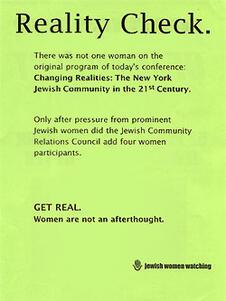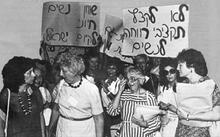Jewish Women Watching
Jewish Women Watching was a Jewish feminist activist group in the 2000s. It fought against sexism, racism, and economic inequality in the Jewish community and was known for its members’ anonymity, costumes, shocking forms of protest, and witty press releases. Over its decade long run of activity, it published anti-sexism ads in Jewish newspapers, mailed condoms and vibrators to Jewish leaders and politicians to advocate against Republican policies from Israel to abortions, and created a fake press release for the Jewish Theological Seminary that promised full egalitarianism in the Conservative movement. Important to its critique was its insistence that it was not opposed to the Jewish community but rather partaking in the long Jewish tradition of dissent by fighting for the Jewish value of social justice.
Introduction
Jewish Women Watching was a feminist activist group of anonymous members based in New York City, active from 1999 to 2010. The group’s primary focus was on the mistreatment of Jewish women by the broader Jewish community, although its members had a wide range of political interests. During their years of activity, Jewish Women Watching led protests against racism, sexism, hypocrisy, and inaction by leaders of Jewish communal institutions.
Due to both the anonymity and, presumably, limited resources of the group, little information is available about Jewish Women Watching and few notable responses to its actions. However, the Jewish Women Watching website (unfortunately no longer available) contained a list of the group’s actions and accompanying press releases, which allows a small glimpse into the ideology and legacy of the group.
Actions
As its mission statement claims, Jewish Women Watching used “satire and factual evidence” as a means to critique “the Jewish establishment.” In October of 1999, for example, seven members of Jewish Women Watching, dressed in masks and tape-covered mouths, protested a Jewish Community Relations Council (JCRC) conference that originally featured only male speakers (six women were added in response to backlash). In addition to the protest, the women handed out flyers calling on the JCRC to “get real” about the importance of women in the New York Jewish world.
That same year, Jewish Women Watching purchased advertisements in The Forward and The Jewish Week with the words “SEXISM IS A SIN” above the Jewish Women Watching logo. The ads appeared in Rosh Hashanah and Yom Kippur issues of the publications in an effort to attract more attention.
In 2002 the group upped the ante by mailing condoms to the offices of more than 3000 Jewish leaders to advise safe sex within the “strange bedfellows” relationship between some Jewish and right-wing Evangelical Christian leaders. The accompanying postcard, attached to the condoms, asked, “Why is the Jewish community in bed with Pat Robertson, Jerry Falwell, and Ralph Reed?” Jewish Women Watching’s press release explained that Robertson, Falwell, and Reed had each expressed anti-Jewish sentiments but nevertheless received praise, and even awards, from Jewish organizations.
In a similar action in 2006, Jewish Women Watching sent vibrators in the mail to politicians, including then-Senator Hillary Clinton, and Jewish communal leaders, such as Abe Foxman of the Anti-Defamation League, in order to “make a buzz” about Jewish silence in response to Republican anti-abortion and anti-sex education laws. Attached to the vibrator came a note that read, “It’s time to Pant for Plan B/Moan for More Condoms/Roar for Reproductive Freedom/Scream for Sex Education.” In the press release, Jewish Women Watching claimed a desire to increase Jewish resistance to abstinence-only education programs and federal restrictions on Plan B (the morning-after pill) and abortions.
A particularly creative form of protest came in 2005 at a Jewish Theological Seminary (JTS) event about the ordination of women into the Conservative rabbinate. At the event, Jewish Women Watching passed out a fake press advisory announcing a JTS plan for gender equity in the Conservative movement by the year 2010. The fake plan promised to close the pay gap between men and women rabbis, ordain gay and lesbian rabbis, and require egalitarianism in all affiliated synagogues. According to the press release, audience members believed the plan to be real and expressed support for it. This made the affair especially embarrassing for JTS when a spokeswoman was forced to admit that it was a hoax and that the seminary was not, in fact, implementing those changes. Following the event, Jewish Women Watching released a statement about the “two faces” of Conservative Judaism: its supposed commitment to egalitarianism and its real life failure to combat inequalities within the movement.
In addition to a flair for creative protest, Jewish Women Watching had a strong sense of Jewish women’s history. In some press releases, the group attributed quotes to inspirational women from the Bible and, in others, to women sharing the names of earlier American Jewish women, including: Adah Menken, the mid-19th century actress, “Clara Lemlich,” a leader in the New York shirtwaist strike of 1909, Bella Abzug, a member of congress in the 1970s, and the entertainer Sophie Tucker.
Response
The critical response to the actions of Jewish Women Watching was somewhat limited in scope. No major Jewish feminist organizations claimed connection to or knowledge of the women in Jewish Women Watching. Other major Jewish organizations had little to say about the group, even when targeted directly.
Much of the response to Jewish Women Watching came in short news clippings, blog posts, and, occasionally, in feminist periodicals like Ms. Magazine and Lilith. When the group was mentioned, the intentionally controversial nature of the actions were as much the topic of conversation as the messages themselves.
A few actions, however, did provoked more serious engagement with the political goals of Jewish Women Watching. The action that received the most backlash was the “strange bedfellows” critique of Jewish communal leadership with right-wing Christian leadership. Multiple opinion writers published pieces in which they expressed anger about the implied critique of Israel by Jewish Women Watching, and one article, from The Israel Report, was titled “Is There Anything Dumber Than Repudiating Christians Who Support Israel?” One commentator took issue with an anti-racism protest in 2010 and stated, “I just wish they'd put the focus back where it started, on sexism, an issue that has not gone away in the organized Jewish community and continues to get too little focus by mainstream leadership” (Cohen).
Jewish Messaging
As both the actions and the responses to the actions indicate, Jewish Women Watching was not solely focused on Jewish women or so-called women’s issues. Rather, its members leveled a more intersectional feminist critique at problems within the Jewish community. For Jewish Women Watching, the “women’s issue” in American Jewish life included concerns about Israel, racism, and voting, in addition to explicit sexism.
As they wrote in 2006, “Our message has expanded over the years to include issues not just of sexism but of other discrepancies within the Jewish community. We are concerned by the assumption that heterosexual, wealthy, traditional, white people are the sole constituents and only possible leaders of Jewish communal organizations. We believe in lesbian, gay, bisexual and transgender access to the rabbinate; in sliding scale fees for synagogue membership and access to Jewish events; in safe work and domestic spaces for girls and women; in honoring the voices of secular and non-religious Jews; and in recognizing Jews of color” (Anonymous 90).
In their effort to make a variety of improvements in American society, Jewish Women Watching appealed to multiple audiences with their actions. Some, like the fake handout at JTS, were directed toward Jewish institutions; others, like the vibrators and an anti-George Bush party at a sex shop, were directed toward politicians, both Jewish and non-Jewish. Regardless of the audience, however, the broad agenda of Jewish Women Watching was consistently represented as Jewish in character even when—perhaps especially when—it was critical of mainstream Jewish ideas, people, and institutions.
In 2003, for example, Jewish Women Watching justified its critique of Jewish leadership by drawing inspiration from Jewish history. It published a satirical newspaper called JewishSpeak, in which it asked, “DISSENT: Is it Good for the Jews?” and answered, “NO.” The article went on to mockingly suggest that a number of prominent Jewish dissenters, including Henrietta Szold and Martin Buber, were not, for this reason, Jews. One sentence reads: “Experts: It is now clear to us that David Ben-Gurion was NOT A JEW.” Here Jewish Women Watching rejects the claim that critique of other Jews is un- or anti-Jewish and suggests instead that dissent is crucial to Jewishness and to the success of the broader Jewish community.
In 2008, Jewish Women Watching made a similar argument but in religious rather than historical terms. Inspired by the Rosh Hashanah idea of the Book of Life, it called on fellow Jews to further their social justice efforts, writing “How will you be written? How will you be sealed?” Here, its calls against the Iraq War and for increased attention to human rights are made explicitly Jewish in their connection to bettering oneself for the Jewish New Year.
By taking on an array of issues from a Jewish feminist perspective, Jewish Women Watching played a role in rectifying common misunderstandings of Jewishness and of feminism within the Jewish world. When it criticized Jewish leaders for choosing “pro-Israel” right-wing Christians over the well-being of Jewish women, Jewish Women Watching made the claim that pro-Israel and pro-Jew were not the same, especially when Jewish women were not adequately included in the category of Jew. When it called on Jews to “embrace the treyf” of unpopular but nevertheless morally correct social justice action, Jewish Women Watching made the claim that sometimes not-typically-Jewish behaviors could be more Jewish than those that are normatively Jewish. And when it called on Jews to vote against George Bush in the 2004 election, Jewish Women Watching made the claim that “the Jewish vote” was not merely a demographic marker but a way for Jews to manifest their Jewishness through political action. For the women of Jewish Women Watching, Jewishness gave rise to politics and politics gave rise to Jewishness.
Conclusion
Although Jewish Women Watching was small in scale and short-lived, the group can serve as a reminder of the creativity and passion of Jewish feminism in the earliest decade of the 21st century. Future Jewish activists groups may not send sex toys to senators or wear owl costumes to protests, but undoubtedly they will continue the fight against sexism, racism, economic injustice, political injustice, and all sorts of other societal ills, including those within Jewish communities.
Anonymous. "Jewish Women Watching." Bridges: A Jewish Feminist Journal 11, no. 2 (2006): 89-92.
Cohen, Debra Nussbaum. “Jewish Women Watching Points Finger at ‘Jewish Racist Voices.’” Forward February 3, 2010.
Greenberg, Eric J. “Hoax Shines Light on JTS Policy on Gays.” Forward April 1, 2005.
Jewish Women's Archive. "Jewish Women Watching declare "Sexism is a sin"." (Viewed on August 14, 2019) https://jwa.org/thisweek/sep/21/2001/jewish-women-watching














